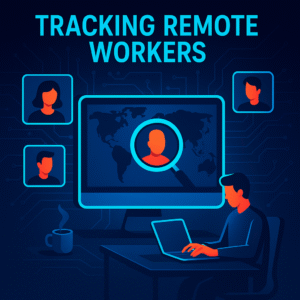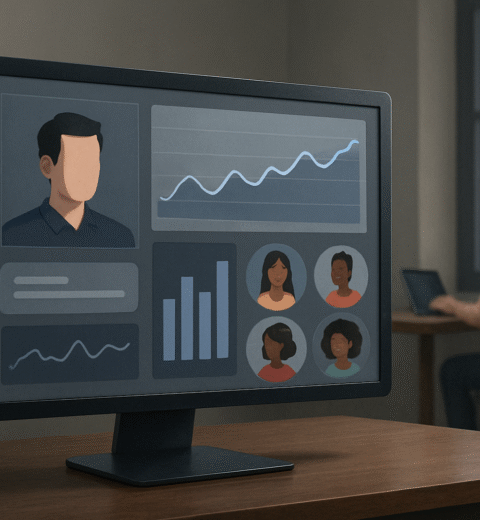Remote work is changing the structure of the modern workplace and presents a challenging issue for companies: how can production be guaranteed without compromising moral values? Employee tracking software is often proposed as the solution, but when does good management end and privacy violation begin?
Why Companies Track Workers Located Remotely
Employee monitoring is really about responsibility. When teams disperse across different time zones and managers operate remotely, they are unable to observe processes in person. Many businesses utilise tracking systems measuring in order to close that difference.
- Hours of labour done
- Websites visited
- Pictures downloaded or screenshots taken at work
- keyboard and mouse activities
- Application usage
- IP-based locational tracking or device monitoring
Usually, these tracking tools are meant to be used for good: to safeguard business data, streamline processes, and ensure fair distribution of work. Still, even with the greatest of intentions, the methods can easily seem intrusive.

The Ethical Argument: Trust vs. Monitoring
Any effective workplace is based mostly on trust. When employees feel trusted, they often are more motivated, committed, and productive. But too aggressive monitoring might erode that confidence and create a hostile climate of mistrust and resentment.
Using tracking software can present moral questions for companies:
1. Cooperation instead of Consent
Though workers “agree” to being watched, was the permission really voluntary? Usually, saying “no” is not an alternative without compromising the employment itself.
2. Overreach in Information
Many tracking devices gather more data than is required—private messages, surfing histories, even keystrokes. This data breach raises major privacy concerns and might lead to abuse possibility.
3. Work-Life Intrusion
Particularly if the software is put on personal devices or utilised after hours, intrusion of work-life monitoring tools may unwittingly delve into private life when remote workers operate from home.
4. Transparent Communication
Do staff members exactly know what is under observation? Many companies have poor communication skills, which leave employees confused or uninformed about the extent of surveillance.
5. Discrimination and Bias
If monitoring was limited to junior staff, outsourced teams, or outsourced freelancers it could cause resentment and suggest unjust treatment. Ethical tracking calls for consistency and fairness.
Is Ongoing Monitoring Essential for Those Who Work Remotely?
In essence, the short answer: No, not constant monitoring.
Remote workers value clear goals, expectations, and communication more highly than they do surveillance. Businesses should evaluate employee performance instead of minute-by-minute working habits. Emphasising deliverables, quality, and timelines helps outcome-based assessment respect individual autonomy while yet assigning responsibility.
Many studies have shown that remote workers often perform better than their counterparts in offices when allowed the freedom to control their own calendar. Constant observation could have the reverse impact, depressing output and morale.

Striking the Right Balance for Ethical Tracking
While some companies might find it impossible to forbid surveillance entirely, there are morally appropriate and employee-friendly substitutes. Here are a few actionable solutions:
✅ Transparency in Policies
Provide a clear, easily understood monitoring policy. incorporate:
- What details are acquired?
- When does monitoring occur?
- Why is this information needed?
- How is it maintained safely?
Workers should be advised of the facts and given the opportunity to ask questions or voice any worries.
✅ Prioritize Outcomes, Not Activity
Use performance-based KPIs (Key Performance Indicators) rather than screen capture measures or mouse movement counts. Focus on:
- Tasks completed
- Project Quality
- Making deadlines
- Client satisfaction
This approach preserves autonomy and strengthens responsibility.
✅ Opt-In and Device Separation
To keep personal devices out of the surveillance loop, let employees use company-provided tools for work or choose to opt out of intrusive monitoring whenever at all possible.
✅ Regular Check-ins Over Constant Surveillance
Announce once a week one-on-one meetings, team stand-ups, and status updates. Without software, these help managers to have insight, improve communication, and build trust.
✅ Team Measures: Private Data
If analytics are needed for more broad productivity patterns, consider adopting systems that compile aggregate, anonymised data rather than tracking individuals.

Legal Aspects What Employers Must Know
Legal as well as ethical, employee monitoring is a concern. Different countries have laws controlling what information companies may get, how they should protect it, and workers’ rights. This is how it goes:
United States
Particularly when employees are using company-owned equipment, United States federal rules give employers a wide degree of latitude in monitoring staff. Still, there are notable limits and subtleties:
- As long as there is a “legitimate business purpose,” employers are allowed by the Electronic Communications Privacy Act (ECPA) of 1986 to legitimately monitor computer activity, emails, and phone conversations. But if the company knows a message is clearly private and the employee objects, surveillance could turn illegal.
- State-Level Laws: Many states—including Delaware, Connecticut, and California—mandate that companies let staff members monitor. Particularly strict on data security and openness are California’s strong privacy rules, including the California Consumer Privacy Act, or CCPA.
- Although federal law does not necessarily demand complete consent, it is recommended practice to let staff members in writing of any monitoring practices to help to lower legal risks.
- Policies About Bring Your Own Device (BYOD): Should employees use their own devices for business, tracking tools could violate personal privacy; should the monitoring be excessive, legal action could follow.
Generally speaking, monitoring is allowed in the United States provided the scope is acceptable and suitable notice is provided. Ignoring privacy issues, meanwhile, may result in penalties, legal action, and public relations disasters.

The United Kingdom
Particularly since the Data Protection Act of 2018 and the General Data Protection Regulation (GDPR), the United Kingdom has enforced stricter rules.
- Employers acquiring and using employee data must have a valid legal justification—also referred to as a “lawful basis”. One has to balance the employee’s right to privacy against “legitimate interest.”
- Employees must be completely and precisely told about monitoring—including what is being observed, why it is required, how long data is retained, and who can access it. Usually, this is achieved with reference to an official Privacy Notice or Employee Monitoring Policy.
- According to the proportionality idea, any monitoring ought to be suitable for the requirements of the company. Clearly illegal would be excessive, all-encompassing surveillance.
- Data Protection Impact Assessments (DPIA) for more intrusive monitoring—such as keystroke logging or tracking after hours—may be required of companies to find and lower threats to employee rights.
- Only very particular events, including criminal investigations, allow covert or hidden monitoring; even then, certain criteria must be met.
Apart from serious damage to reputation, disobedience could lead to hefty fines from the Information Commissioner’s Office (ICO).
🌍 Globally: GDPR and Beyond
Employee data is safeguarded as personal information in several countries, most notably the EU and other countries which have adopted the GDPR. This entails:
- Employees have rights to know what information is being compiled.
- Workers could be entitled to view, change, or delete their personal records.
- Data has to be maintained securely and for as little time as is necessary.
- Businesses should examine whether monitoring could be deemed legally “excessive.”
International companies must be very careful and ensure that their monitoring practices fit the national legal systems of every country.
Important Legal Knowledge for Companies
- Every employee should be aware of any monitoring initiatives constantly.
- Keep observing in line and with a clear eye towards corporate needs.
- Limit tracking to work-related activity and protect personal data
- Document your policies, award staff members, and routinely update them.
- Ask legal counsel before introducing new popular monitoring tools, particularly across numerous countries.
Ignoring these rules not only puts companies in risk but also costs millions in fines and damages their reputation and staff confidence.

Better Remote Teams
Thanks to technology, we today have incredible tools for distant communication; nevertheless, great power comes with great responsibility. Companies have to carefully weigh protecting their interests against maintaining employee privacy.
Not one of the questions is, “Can we track remote employees?” The inquiry is, “Should we?” The answers are openness, trust, and treating people as human beings instead of machines. Companies who can move from monitoring to empowerment will produce better teams and cultures.





